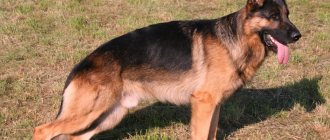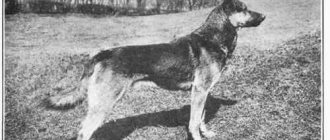Beginning breeders of German shepherds or owners of pregnant shepherds should prepare in advance for the birth of an animal at home. You should not completely rely on nature and naively hope that the birth of a German Shepherd will go well without human intervention. Not even for the first time, a dog giving birth needs a birth block, support from the owner, and sometimes even veterinary care during childbirth.
Owners of first-time mothers often have to deliver their pet, resuscitate and feed newborns.
How to Prepare for a German Shepherd Giving Birth
Proper preparation for a joyful and important event is the key to a successful outcome of the birth; for this, the owner of a pregnant shepherd is recommended to perform the following steps.
Determining the due date
The average gestation period for a German Shepherd is 63-65 days, although sometimes a female dog whelps after 58 or even 72 days. After mating, the owner must immediately mark the expected date of birth on the calendar.
Preparing the maternity unit
Regardless of the method of keeping the dog, it is advisable that the pregnant bitch gives birth in a warm, dry room with an air temperature of 28-30C to avoid possible hypothermia of the newborn puppies. In this room, 10 days before the birth, it is necessary to properly build a maternity unit. This can be a collapsible playpen made of wooden panels measuring 2x2 m with a side height of 50-70 cm and an internal ledge along the entire perimeter. You can simply fence off a corner of the room in a warm, bright room, away from drafts and direct sunlight.
Before giving birth, one wall must be removed; it is not recommended for a dog in this position to take the barrier. At the bottom of the birth block you need to lay an oilcloth with any cotton fabric on top of it. The dog must be placed in the birthing unit a week before giving birth, otherwise at the crucial moment the bitch will simply end up giving birth in a prepared place and choose any secluded corner at her discretion.
Maternity unit made from scrap materials
Diet
A week before the long-awaited day, it is necessary to exclude meat and fish products, as well as salt, from the pet’s diet to prevent the occurrence of eclampsia, which is fraught with premature or pathological birth.
Preparing medications and supplies for childbirth
The owner of a pregnant dog needs to prepare medications and supplies in advance in order to help the shepherd and her puppies in time.
During childbirth you may need:
- dry sterile diapers or pieces of cotton fabric;
- cotton wool;
- sterile petroleum jelly;
- gloves and syringes;
- infrared lamp or heating pad;
- box for newborns;
- pen and notepad;
- disinfected surgical scissors;
- gray and colored threads;
- scales;
- hydrogen peroxide solution;
- glucose and calcium gluconate;
- oxytocin;
- iodine;
- carvalol;
- cordiamine;
- goat milk;
- pipettes;
- drinking water;
- meat broth.
Agreement with a veterinarian
It is highly not recommended to transport dogs in the event of an unforeseen situation at the time of birth of puppies. It is advisable that emergency assistance be provided to the dog at home. To do this, you should agree in advance with an experienced specialist about the possibility of providing assistance at any time; most often, dogs give birth in the evening or at night.
Signs of pregnancy
It is possible to understand that the dog is in an “interesting” position only in the second month after conception. Of course, this can be done by an experienced veterinarian in the first half of pregnancy using ultrasound and palpation. But in the early stages the owner himself is unlikely to determine this correctly.
However, there are some features and signs by which you can understand that the shepherd will soon become a mother. They appear one after another as the gestation period of the puppies increases:
- The bitch suffers from constant bouts of thirst.
- She is in a lethargic, apathetic state.
- The shepherd's chest and nipples swell and increase in size.
- The belly begins to show.
- The shepherd weighs more than before pregnancy.
- Next, you can notice that the shepherd’s belly has dropped.
- Colostrum (first milk) is released in large quantities, and discharge from the genitals also appears.
- Real milk is formed a week before birth, and sometimes after it.
Signs of labor in a German Shepherd
You can determine the approach of the long-awaited moment by changes in the appearance and behavior of the German Shepherd before giving birth.
Change in appetite
In the last weeks of pregnancy, the animal begins to sort through food; a couple of days before giving birth, some individuals completely refuse food and water.
Refusal to eat in the last days of pregnancy indicates the approach of labor
Descent of the abdomen
Shortly before the crucial moment, the rounded belly drops down, and deep depressions appear on the dog’s sides, as if the pet is severely exhausted. This phenomenon is absent in primiparous bitches.
Anxiety
As the puppies move towards the birth canal, intra-abdominal pressure occurs, causing pain and discomfort to the pregnant female, body tremors and rapid breathing are observed. The dog tries to be alone, it can whine, tear the bedding, linoleum, furniture; animals are most worried during the first birth. It is impossible to scold or punish an animal in such situations; stress can cause premature birth and death of puppies.
Vaginal change
As the baby approaches the birth, the vulva becomes enlarged and swollen; it becomes soft, moist and loose.
Plug coming out
When the cervix opens, a mucous plug of gray, white or greenish color is released, which indicates that labor is approaching. During pregnancy, the cork served as a natural barrier protecting the fetus from infection from the outside.
Decreased body temperature
The day before birth, under the influence of hormones, the rectal temperature decreases to 37C.
Swelling of the nipples
Shortly before the birth of babies, and in firstborns just before birth, the mammary glands become enlarged, the nipples swell, and sometimes colostrum is released.
How do German Shepherds give birth?
Most often, in dogs, labor begins late in the evening or at night, although the physiological process does not depend on the time of day. In German Shepherds, labor lasts on average 3-15 hours. The duration of birth of puppies directly depends on the number of babies in the litter. Childbirth usually lasts the same number of hours as there are newborns in the brood. The process of childbirth begins with contractions, during which the contracting uterus expels the fetal bladder from its cavity. Contractions are manifested by convulsive muscle contractions, rapid breathing with an open mouth. Contractions are subsequently joined by painful pushing - contractions of the abdominal wall muscles, aimed at moving the fetus out through the birth canal. During pushing, the dog strongly strains its stomach, lifts its tail and stops breathing.
A pregnant female can give birth in a supine position, resting her limbs while pushing against the wall of the birth block or any solid object. Some dogs give birth while standing; in this position, the owner needs to take the newborns in his arms in time to avoid them falling.
If a German Shepherd sits during labor, it is necessary to lift the female on her hind legs to clear the exit of their birth canal.
The largest puppy is born first; it is highly not recommended to interfere with this process, which is the starting mechanism for the successful course of all births. The fetus moves along the birth canal in the membranes; immediately before birth, a water bladder with amniotic fluid bursts, facilitating the baby’s movement along the birth canal. After the water has drained, the puppy must be born no later than 2 hours later, otherwise the baby may suffocate.
The cub is born in the membranes, an experienced dog independently frees the baby from the membranes, the interval between the birth of the cubs can be from several minutes to an hour. The bitch gnaws the umbilical cord and licks the newborn, thereby massaging the intestines and stimulating the first act of breathing. After licking, it is advisable to put the puppies in a box with a diaper so that the female does not crush the born babies during the next attempts. The owner must record the weight, gender and number of the newborn in a notebook and loosely tie a colored thread around the neck for marking.
If he does not lick his puppies immediately after birth, the owner himself needs to rupture the fetal sac, cut the umbilical cord and clear the newborn’s nose and throat
Following the cub comes the afterbirth, rich in protein and hormones. The owner of a German Shepherd needs to control the number of pups and placenta born to prevent the development of endometritis. The shepherd dog should eat no more than 3-4 placentas to stimulate uterine contractions and breast milk production without developing diarrhea. If more than 2 hours have passed since the last puppy, the dog’s belly is soft, and the number of afterbirths released corresponds to the number of offspring, the birth can be considered complete.
How does childbirth go?
No matter how many puppies are born for the first time, competently delivering a baby to a shepherd is not as easy as it might seem at first. The fact that the woman in labor has begun is indicated by her behavior: she tosses and turns and whines, since all this is accompanied by painful sensations. Often the dog is trying to get back on its feet, so it will definitely need your help.
What exactly is recommended for a dog breeder to keep an eye on:
- so that the puppy is born without outside interference. The outer membrane is ruptured only after the baby has fully emerged;
- so that your pet does not touch the water bubble under any circumstances. Otherwise, she will simply damage it.
Prepare a separate container in advance where you will need to put the puppies. It is recommended to cover the bath with a thick layer of gauze and some kind of blanket. How long does it take between contractions? Typically around 20–60 minutes.
How to help a German Shepherd during labor
You should not interfere in the process of a successful birth; the owner should only support and reassure the pet with gentle words.
The minimum help is to cut off the umbilical cord with sterile scissors 3 cm from the newborn’s body. But a dog and its babies truly benefit from human intervention in the following situations.
The female is not interested in the newborn
It is necessary to independently rupture the membranes, cut the umbilical cord, free the baby’s nose and mouth from mucus with a gauze cloth, massage the tummy with a damp swab and clean the anus of meconium, after which it is advisable to place the puppy to the mother’s face for licking.
The dog has no milk
Sometimes the baby is born, but colostrum has not yet been produced. In such a situation, it is necessary to feed the baby warm goat milk from a syringe. It happens that the puppy cannot suck on his own. In order to help the baby, it is recommended to squeeze a drop of milk onto the nipple, then put it into the baby's open mouth. The baby should latch on and eat.
Before giving birth, you should purchase goat milk and pipettes in case the mother does not have milk.
A dog crushes babies, gnaws the umbilical cord until a hernia forms, eats puppies
Bitches giving birth for the first time may experience a lack of maternal instinct, postpartum shock, or increased licking of the belly; all these psychological disorders can cause the death of the entire litter. If the mother crushes or gnaws the newborns, it is necessary to urgently transfer the babies into a box under a lamp and remove them from the nest. Perhaps, having recovered from the shock, the mother will accept and feed her children. But most often in such situations, it is recommended to find a nursing foster mother and show the woman in labor to a specialist to determine why the German Shepherd eats its puppies. Perhaps the cause is hidden pathologies, vitamin deficiency, early or late pregnancy, lack of nutrients.
The dog is tired, but labor is not over yet
You can take the dog outside for a short jog, drink cold sweet tea or meat broth, after which you can massage the abdomen in the direction from the hips to the pelvis and internal massage of the vagina.
The fetus is stuck in the birth canal
Depending on the presentation, they fix it with two fingers and lubricate the emerging part of the body with sterile Vaseline, then carefully pull out the newborn in time with the attempts.
Video: how to help if a puppy is stuck in the birth canal
The water has broken, but the puppy is not born
If labor is weak or to save the baby’s life, the woman in labor can be given an injection of oxytocin or pituitrin to stimulate contractile activity of the uterus.
If self-help does not bring success, the female strains for several hours, and the puppies do not come out into the world, bleeding occurs and severe weakness in the animal, it is necessary to urgently call a veterinarian at home. The mother may need to have a caesarean section to save the life of the dog and her babies.
What to do after giving birth with a dog and puppies
After the birth of the babies, the owner must create optimal conditions for the mother to restore her strength and raise furry babies:
- It is necessary to wash the animal's fur and walk the dog for a long time in an apron that protects the mammary glands and open birth canal from infection. After each walk, you need to wipe the mother’s paws and belly to avoid infection of the babies;
- during a walk, you need to change the dirty bedding, examine and weigh all newborns;
- if the dog is breathing heavily, there is drooling, rapid heartbeat, increased body temperature, purulent discharge from the uterus, it is urgent to give the dog Carvalol or Cordiamine and call a veterinarian at home;
- Cotton bedding for newborns should be changed daily, subjecting them to disinfection, washing and ironing;
- For several days after giving birth, you should ensure that the bitch does not bite or crush the babies, that the cubs are fed and are located near the mother’s body;
- If puppies squeak all the time and sleep little, most likely they do not have enough mother’s breast milk. In this case, it is necessary to introduce lactogenic additives into the diet of the lactating bitch and feed the babies with goat’s milk;
- A nursing bitch must be fed a highly nutritious diet with increased protein and calcium content. It is also necessary to ensure that the dog always has a full drinking bowl to replenish lost fluid.
Babies sleep a lot and squeak little if they are full
Nutrition
As a rule, bitches who have given birth may themselves refuse to eat for 24 hours, drinking only large amounts of drink. Perhaps the shepherd simply does not have the strength to eat due to a serious weakening of the body, but, according to experts, after whelping its digestion is disrupted, which also causes fear in the bitch.
Therefore, it is recommended:
- do not panic when your pet has diarrhea;
- Give a couple of tablets of activated carbon along with your drink (it is better not to resort to the use of other “strong” drugs);
- try to feed the dog in small portions;
- in the first 3 days, give preference to fermented milk products, crushed into a semi-liquid state (for example, cottage cheese with sour cream or kefir);
- high-calorie foods (such as raw meat) are prohibited to be given in order to avoid an excess of milk and, as a result, the occurrence of mastitis;
- gradually, in small portions, you can introduce well-cooked, lean meat (chicken and beef), as well as broths;
- standard dry and liquid industrial food should not be given thoughtlessly (a separate line of food has been developed for lactating bitches; however, you will have to buy them in small quantities at first and observe the dog’s appetite for them);
- Along with raw vegetables and fruits, you can introduce special vitamin and mineral supplements into your diet (of course, after consulting with your veterinarian first).
3-4 days after giving birth, the shepherd's colostrum changes to full milk. This process is accompanied by a short-term emptying of the mammary glands; the puppies react violently with squeaks and anxiety to the lack of food. Don’t panic, now mommy needs to be given more liquid (water or kefir), the milk will appear soon. Make sure your dog receives adequate nutrition and sufficient fluids during this period. Perhaps the bowl of food and drink will have to be brought closer to the playpen in the first days, because mommy is afraid to leave her offspring even for a few minutes. If the litter is small, the amount of food and liquid must be selected individually to avoid the development of mastitis.
The correctness of the nutrition the shepherd receives during this period is best indicated by the appearance and behavior of the puppies. A healthy puppy is calm, clean, has a shiny coat, and is constantly gaining weight.
How many puppies does a German Shepherd give birth to?
A German Shepherd in adulthood produces an average of 6-8 puppies, although a litter may consist of 1-14 newborns. Dogs have 5 pairs of nipples, so small litters are optimal for maintaining the health of babies. In the first litter, the bitch gives birth to 5-6 puppies. The size of the brood depends on the number of mature eggs in the body of the expectant mother at the time of mating. Females 6-8 years of age, as a rule, give birth to small litters consisting of 1-3 puppies. To maintain the health of the bitch, it is recommended to breed the dog no more than once a year.
Caring for newborn puppies
In order not to confuse the babies, and to track weight gain and general development, it is worth tying ribbons of different colors immediately at birth.
Newborn German Shepherd puppies are born blind and deaf, with soft dark fur, long hair and a large rounded head. The normal weight of healthy babies at birth is 350-500 g. Caring for newborn German Shepherd puppies is quite troublesome; the owner needs to create safe and comfortable conditions for the growth and development of the young:
- the birth unit with puppies should be in a room with an air temperature of 28-30C, the bedding must be disinfected and washed daily;
- dewclaws are removed from newborn babies;
- The owner needs to ensure that all the babies are fed. Despite the fact that babies' eyes open only on the 10-15th day, newborn strong cubs quite actively find and fight for the mother's rear milk nipples, pushing away weaker brothers and sisters;
- with a large litter, it is recommended to feed the puppies in turn; well-fed puppies are put in a separate box for 2-3 hours, where they are fed with goat’s milk. An alternative option is to nurse with a foster lactating bitch;
- In the first week, babies should feed on breast milk at least 12 times a day, in the second week - 8 times, and in the third week - 4-5 times. Well-fed babies behave calmly and often sleep;
- German Shepherd puppies begin to hear only 12-15 days after birth, when newborns' eyes are already fully open. Full hearing develops only at the end of the first month of life. Sighted puppies begin to actively explore the world around them, so in order to avoid accidents, it is unacceptable for babies to leave the maternity ward at such an early age.
- once a week it is necessary to cut the claws of babies in order to avoid damage to the skin of the nipples of a nursing bitch; if cracks appear on the nipples, they must be lubricated with sea buckthorn oil or Vaseline;
- from 2 weeks it is necessary to feed babies with porridge, and from 3 weeks with calcined cottage cheese, raw scraped veal and rice water. It is necessary to give growing young animals vitamins A and D daily;
- It is recommended to separate puppies from their mother no earlier than 2 months, gradually replacing one feeding with adult food.
With careful preparation and study of the physiology of an important process, the birth of a German Shepherd ends in the birth of charming furry babies. German puppies are very cheerful, funny and inquisitive pets, which, with proper care and education, grow into true loyal friends.
Caring for a pregnant dog
The birth of your German Shepherd will be successful at the right time if you create a calm atmosphere for your pet and take care to eliminate any possible stress. As for nutrition, it should be balanced. Protein foods are especially beneficial for dogs. It is also advisable to include vitamins in your daily menu. During pregnancy, the shepherd dog should eat more cottage cheese, fish, meat and eggs.
Undesirable foods include carbohydrates: various cereals and soups are not the best option for a pregnant bitch. Interestingly, during the eight-week period a dog is pregnant with puppies, it is recommended to completely exclude meat from its diet. It is better to replace it with fish.
It's not just nutrition that needs to be taken seriously. The duration and frequency of walking your pet deserves special attention. It is recommended to take the bitch for a walk several times a day, especially when the birth is approaching.
It doesn’t matter how many puppies a pregnant dog has: when the litter is about to be born, and there is no more than a week left before the start of labor, it is very important to measure the dog’s temperature every day.
If it is reduced by one degree, it is time for you to prepare to accept the litter. It is believed that no more than a day should pass from the moment the temperature drops before your pet gives birth. Let’s say the allotted time has expired, but there are no changes in the dog’s well-being. In this case, you should seek help from a veterinarian.










